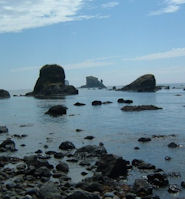|
 Dwight Peck's personal website Dwight Peck's personal website
Summer
2004
The
Olympic Peninsula in Washington, USA
You
may not find this terribly rewarding unless you're included here, so this is a
good time for casual and random browsers to turn back before they get too caught
up in the sweep and majesty of the proceedings and can't let go.
Ozette
Lake and Cape Alava
It's
the 18th of July, so we need to march from the ranger station at Ozette Lake out
a fairly incredible boardwalk path three miles to the Pacific at Cape Alava, supposedly
the westernmost point in the lower-48 of the USA. More rain forest -- impassable,
one would have thought, without this boardwalk.
The
informative Makah Indian Museum at Neah Bay
to the north, which displays artifacts and reconstructions of life in an Ozette
Indian coastal village that was buried in a landslide some hundreds of years ago
and excavated (and then reburied) in the 1970s and '80s, tells tales of both Indians
and the first white settlers moving between the coast and the Ozette Lake taking
weeks and months for the trip, but it only took us an hour and a half, thanks
again to the boardwalk.
The
coastal Indian tribes were formerly fisherpeople and whalers, evidently, and stuck
to the sea and rivers in hollowed-out log boats rather than getting themselves
all tangled up in these forests.

Descendants
of the white settlers hung on around the lake well into the present century, presumably
slashing their way to the outhouse once or twice a day with machetes, but eventually
gave it up. The Hoko-Ozette road from Sekiu on the Strait of Juan de Fuca (the
only road in the area) was laid on in recent times, and that's definitely the
way to go for those of us with a hired car and promises to keep.
It's
easy to see why the first white settlers might have taken so long moving their
refrigerators and home entertainment centres through this mess to get set up in
their new digs on Ozette Lake.

-- Enough
historian's lugubrious reflections, Cape Alava is waiting.

Ozette
Island off Cape Alava. The reburied archaeological site lies a half-mile to the
north, but the classic walkers' route goes south, so we munch our lunch and turn
left.

This
is the classic Olympic coastline, all those . . . things! out there, and varying
in aspect by the minute as the tide edges in and out.

The voie
normale or classic route goes from Ozette out the boardwalk path three miles to
Cape Alava, then three miles south along the beach to Sand Point, then three miles
back to Ozette by another boardwalk path. It's brilliant, and requires only a
little forethought on the timing, as a few places along the coast become tidally
impassable when the waves lap right up against the treeline.
Here's
Kristin walking southward along the coast, at a place marked on the maps as "Wait
for low tide or use overland trail if available".

Time for a break

Cape
Alava from the south

Aesthetically
pleasing effects of imperfect erosion processes from a bygone era. Harbor seals
play king-of-the-mountain on many of the offshore rocks, thumping each other off
into the sea.
Kristin
relaxing at a roadside rest stop


The
way southward, Sand Point in the distance.

Kristin
hikes along the rocks in her "hiking sandals", which let the feet breathe.
Tide's
starting to come in now. We hasten to Sand Point and then three miles back through
the forest to Ozette -- almost time for dinner in La Push!!

This
is probably a line of asylum-seekers working their way around the Homeland Security
Billy Bobs watching for them at the airports and train stations.
 Feedback
and suggestions are welcome if positive, resented if negative, Feedback
and suggestions are welcome if positive, resented if negative,
 .
All rights reserved, all wrongs avenged. Posted 24 September 2004, revised 27 April 2013. .
All rights reserved, all wrongs avenged. Posted 24 September 2004, revised 27 April 2013.
|
 Dwight Peck's personal website
Dwight Peck's personal website


























